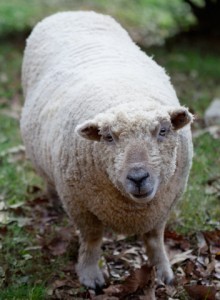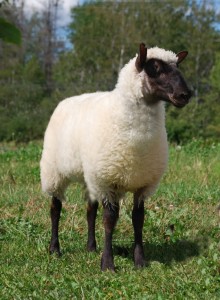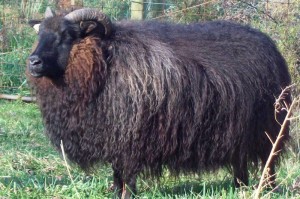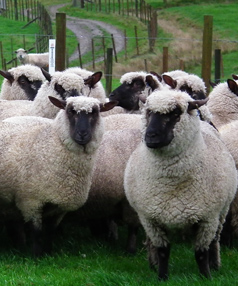Sheep have been raised for centuries by people all over the world because they’re versatile and hardy.
They’re a good livestock choice for people who are preparing for a disaster situation because they don’t eat as much as larger stock animals, and will also eat vegetation that cows won’t touch. While many breeds are only “wool breeds”, “meat breeds” or “milk breeds”, some are good, solid multi-purpose animals.
Just like with many animals, some sheep thrive better in different climates. If you live in an area that has extremes in temperature or weather, you may want to search for a breed that thrives in your climate.
Also, there are many different factors that go into choosing the right sheep for your needs. If you plan on keeping cattle for milk and meat, then those qualities may not be as important to you as the quality of the skin and wool.
Multi-Purpose Merinos

Multi-purpose merinos are the result of 15 years of breeding using genetic studies, conformation standards and genetic preferences applied by meat breeders and biological technology used to determine quality and growth rates of wool fibers as well as skin. All in all, this isn’t a sheep bred for showing but that’s not what we’re going to be using it for, anyway.
A bonus with this sheep is that, since the skin is wrinkle-free, the hides are fine and relatively easy to work with. It’s been compared to the quality of Moroccan goat skin so the hides would be great for clothing or for trading.
Clun Forest Sheep

The Clun Forest sheep is medium-sized, with rams typically growing to 175-200 pounds and ewes maturing between 130-160 pounds.
Clun Forest sheep are adaptable and hardy sheep that yield plenty of milk, sweet meat, and a creamy white fleece. Twins are typical so they’re also prolific and thus sustainable. They thrive on just grass, are disease- and parasite-resistant, and easy to keep.
Icelandic Sheep

They have been cross-bred a bit, which resulted in a more disease-resistant sheep. They were imported to Canada for the first time in 1985, making their way to the States in the 1990’s.
They have a double-layered coat that consists of an inner layer of soft, fine wool and a water-resistant outer layer that is longer and courser, growing as long as 15 inches. The fleece may be gray, black or brown and may also be patterned.
{adinserter backyardliberty}The skin is thick enough to use for rugs but still fine enough to be used for clothing. The meat is lean and tastes sweet. As a matter of fact, they’re bred almost exclusively for their meat in their native Iceland.
To add even more weight to the argument that this sheep is great to raise for a SHTF situation, the milk is gaining popularity for both drinking and cheese-making purposes. They’re short and stocky, with the rams weighing in around 180-220 pounds and the ewes at 130-160 pounds.
The ewes are easy breeders and good mothers that typically produce hardy twins and sometimes triplets. Add in the fact that Icelandic sheep are feed-efficient and you’ve got a great sheep to raise for a SHTF situation.
Shropshire Sheep

They withstand wind, cold, sleet, and snow extremely well. The Shropshire sheep made its way to the States in the late 1800’s and has been a popular farm sheep ever since.
Adult rams weigh between 226-250 pounds and ewes weigh between 150-180 pounds. The wool is thick and luxurious. The meat is tasty and plentiful. Finally, the ewes birth easily and typically live long lives. These sheep are gentle enough that kids can easily help with their care; in fact, they’re often used for 4-H sheep.
Final Words
Choosing the right sheep to meet your needs involves way more than we can discuss in one article. The amounts of lanolin in the wool and the length and texture of the hair all vary widely from breed to breed as does the flavor and nutritional quality of the meat and milk. Skins also range from extremely wrinkly to smooth and from thick to thin.
Our goal here was simply to suggest a few good sheep that may be raised in as many different climates as possible. We looked for ones that were sustainable so we considered disease-resistance, breeding habits, and feeding needs as well as physical characteristics. In other words, this is a good spring-board to start you on your search for the perfect sheep for your particular SHTF needs.
This article has been written by Theresa Crouse for Survivopedia.
[yasr_visitor_votes]









Happyclinger | December 9, 2013
|
The email said there were 4 breeds – only see 3 here…is there a 4th? Thanks!
admin | December 10, 2013
|
Thank you for noticing, Happyclinger. We have repaired the error.
Linda | December 9, 2013
|
Before people take on these different projects that are suggested at the recommendation of survivorpedia, may I recommend doing your research. Be aware of common associated problems/ailments/care needed. These are living beings and it’s not a matter of give them food and water and hope for the best.
It would be responsible of this site to include appropriate (point form) information covering, at least, the expected topics on basics of care, such as foot care, docking of tails, shearing without electric clippers, etc that goes along with the undertaking. I’ve seen many hobby farmers fail, lots of animal suffering and unbelievable levels of lack of common sense.
….~*~….
Doug Cooper | December 9, 2013
|
Storey’s Guide to Raising Sheep might be helpful. It is available at Tractor Supply and Amazon and probably other places.
admin | December 9, 2013
|
You pointed out good topics that we took into consideration for the next weeks. Thank you for your feedback, Linda.
Linda | December 9, 2013
|
What I’d really like to see is a list made of necessary skills/jobs and perhaps subsets.
Truly, ideally, we will need a group of fellow peeps…. to do all, know all is a heck of a task!!!
Areas of expertise, kinda thing….
Mechanical (plumbing, electrical, etc)
Food production/preservation
Animal care
Communications
Shelter building
Map making, directional ability (?)
First Aid
…you get the picture….
A subset of animal care would be a farrier, for instance.
Hope all can think that thru and make a list so we can go spying our friends and figuring out who has needed talents…or start searching somewhere.
…~*~…
Jacki =^..^= | December 11, 2013
|
If you want to learn to can get the book “Canning for Dummies” and there should be a booklet with your pressure cooker. That’s how I learned. My only suggestion is to raw can meats or they will overcook when you use them. I can venison when my husband brings it home.
Dorothy | January 7, 2014
|
re Farrier work. I haven’t done goats recently but they were pretty obvious as to where to trim off the excess foot. If you have a horse that goes barefoot (no shoes) you can learn by buying a GOOD rasp and rasping (filing) to maintain the same angles your farrier does. Skip one time, then have the farrier check what you have done. Some farriers will not be thrilled that you are trying, others will show you what to do. We raised foundation Appaloosa with rock hard feet that seldom need any trimming. Some breeds now have “soft” feet that require shoes if used outside of soft ground. That is also something to consider: if your horse needs constant professional care to be comfortable .. maybe not the best long-term.
Ken S | December 10, 2013
|
One thing with sheep is you HAVE to worm them EVERY 20 days from spring to Fall and the good wormer is a little expensive we use sydectin at $260 a gallon and a gallon treats app 300 sheep 1 time. Without worming many of the sheep WILL die . We raise Katadins they are one of the most worm tolerant breeds Yes we still have to worm but done have to worm the whole flock each time. we look for signs of worms and treat as necessary the whole flock gets wormed spring and fall we raise them for sales and meat they are a Hair sheep you don’t have to sheer them.
Linda | December 13, 2013
|
I recommend people research this and use natural alternatives. If SHTF worming products won’t be available and they just create more resistant strains of worms. Garlic juice (concentrated) is supposed to work well and diatomaceous earth is another possibility. Diatomaceous earth is a good thing to keep on hand as it has a few good uses for some difficult scenarios.
Would be great if there was a list compiled for worming all creatures (including people) as lots of natural possibilities like carrots or walnuts can be effective for different scenarios.
…~*~…
Kelly | February 14, 2019
|
What about large amounts of cucumber and pumpkin seeds as well? Also the herb wormwood, which is aptly named, which contains the “drug” artemether. I have heard these things can help PREVENT worm infestations, but (I imagine, unless QUANTIFIED as a concentrate) can they really treat a worm infestation. obviously we know that using not enough of something can cause resistance, herbs included, so I would want to somehow quantify the active ingredients somehow. This information isn’t as readily available in modern medical times. You’re right, if SHTF no one is going to be able to just obtain ye olde praziquantel anymore! I work in veterinary medicine and I often think that in Western medicine we rely too HEAVILY on synthetic pharmaceuticals and treating symptoms directly rather than holistically. I find that a mix of the two works best, but medicine’s roots should NEVER be forgotten….esp if shtf! I am super interested in raising the Icelandic sheep by the way. I am in MA on 3.5 acres, currently just raising ducks and chickens, gardening, learning to can, planning the rest of the farm, and saving money for fencing (and a new roof for the house, lol, might take a while….) Also I think I’m rambling now, but I also have learned in large animal medicine that keeping grass shorter than 4″ helps prevent parasite transmission.
Carol Barnes | December 10, 2013
|
I liked the artical about the different types of sheep. Thanks.
Sarah Spencer | December 10, 2013
|
I appreciate all you do and all you share.
My question on sheep:
Are there any that are hypo-allergenic?
The last time I tried to wear wool, I have to use a liner. I am allergic to wool directly against my skin. It would also be nice to have care instructions for wool clothing. I accidentally ruined a skirt not knowing it needed to be dry cleaned.
Jacki | December 11, 2013
|
There is a breed of sheep that was developed last century called the Targhee. They are crosses of Rambouillet, Lincoln, and Corriedale breeds and were bred in Idaho. They were bred for wool, meat and the fact they almost always have twins. I don’t remember worming them more than 2x a year except the lambs. They are a taller sheep which should make them easier to milk than some of the breeds you mentioned. I actually prefer the Targhee to the Shropshire for eating (we had both)and you definitely get more wool. Being developed in Idaho, they’re a hardy breed and during the summer are fine out in the pasture with nothing but a large tree for shelter, as long as they have a supply of water. Foot care, shearing, docking and castrating aren’t that big a deal. Granted I’ve never sheared a sheep without electricity, but if you don’t have to keep the fleece in 1 piece manual shearing shouldn’t be too bad for that length of time after you get used to the hand shears. And if you do want the fleece in 1 piece, well, practice makes perfect.
Sheep will eat chewing tobacco and I can’t even imagine that not helping with worms. I just gave it to my pet because she liked it, we had primarily a show herd for 4-H and FFA,(oh so long ago)so I could have a breeding ewe for a pet but never ever a lamb. I never knew when they were going to be sold or slaughtered.
You can wash a wool garment in cold water and hang it to dry as long as absolutely no heat blows directly on it. As for your wool allergy the hair sheep previously mentioned may be your solution. My mother and sister are both allergic and can’t stand to wear wool. I find it a little itchy but not enough to quit wearing it.
Sarah Spencer | December 11, 2013
|
Thank you Jacki, I think you answered my most important question concerning whether or not there was a hypo-allergenic breed. Thanks for the laundry question too.
Brad | December 21, 2013
|
What breed would be the best breed for a more tropical climate like mid elevation Costa Rica. Targhee? or
Pingback:Growing Plants For Textile Fibers | Survival skills, survival guns, survival guide | January 18, 2015
|
Pingback:Growing Plants For Textile Fibers | The Prepper Dome | January 18, 2015
|
Pingback:How To Grow Plants For Textile Fibers | January 22, 2015
|
Pingback:Back To Basics: How To Turn Wool Into Yarn | Survivopedia | April 17, 2016
|
Pingback:Back To Basics: How To Turn Wool Into Yarn | Prepper's Survival Homestead | April 17, 2016
|
Pingback:Back To Basics: How To Turn Wool Into Yarn | | disasterdefense.us | April 17, 2016
|
Pingback:Healthy Low Carb Foods To Stockpile For Survival | Survivopedia | June 27, 2016
|
Pingback:Healthy Low Carb Foods To Stockpile For Survival | Prepper's Survival Homestead | June 27, 2016
|
Pingback:Healthy Low Carb Foods To Stockpile For Survival | | disasterdefense.us | June 28, 2016
|
Pingback:How To Choose Warm Clothes For Cold Days | Survivopedia | January 3, 2017
|